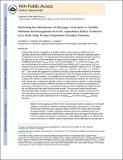Revisiting the Mechanism of Dioxygen Activation in Soluble Methane Monooxygenase from M. capsulatus (Bath): Evidence for a Multi-Step Proton-Dependent Reaction Pathway
Author(s)
Tinberg, Christine E.; Lippard, Stephen J.
DownloadLippard_Revisiting the mechanism.pdf (944.2Kb)
PUBLISHER_POLICY
Publisher Policy
Article is made available in accordance with the publisher's policy and may be subject to US copyright law. Please refer to the publisher's site for terms of use.
Terms of use
Metadata
Show full item recordAbstract
Stopped-flow kinetic investigations of soluble methane monooxygenase (sMMO) from M. capsulatus (Bath) have clarified discrepancies that exist in the literature regarding several aspects of catalysis by this enzyme. The development of thorough kinetic analytical techniques has led to the discovery of two novel oxygenated iron species that accumulate in addition to the well-established intermediates H[subscript peroxo] and Q. The first intermediate, P*, is a precursor to H[subscript peroxo] and was identified when the reaction of reduced MMOH and MMOB with O[subscript 2] was carried out in the presence of ≥540 μM methane to suppress the dominating absorbance signal due to Q. The optical properties of P* are similar to those of H[subscript peroxo], with ε[subscript 420] = 3500 M[superscript −1] cm[superscript −1] and ε[subscript 720] = 1250 M[superscript −1] cm[superscript −1]. These values are suggestive of a peroxo-to-iron(III) charge-transfer transition and resemble those of peroxodiiron(III) intermediates characterized in other carboxylate-bridged diiron proteins and synthetic model complexes. The second identified intermediate, Q*, forms on the pathway of Q decay when reactions are performed in the absence of hydrocarbon substrate. Q* does not react with methane, forms independently of buffer composition, and displays a unique shoulder at 455 nm in its optical spectrum. Studies conducted at different pH values reveal that rate constants corresponding to P* decay/H[subscript peroxo] formation and H[subscript peroxo] decay/Q formation are both significantly retarded at high pH and indicate that both events require proton transfer. The processes exhibit normal kinetic solvent isotope effects (KSIEs) of 2.0 and 1.8, respectively, when the reactions are performed in D[subscript 2]O. Mechanisms are proposed to account for the observations of these novel intermediates and the proton dependencies of P* to H[subscript peroxo] and H[subscript peroxo] to Q conversion.
Date issued
2009-11Department
Massachusetts Institute of Technology. Department of ChemistryJournal
Biochemistry
Publisher
American Chemical Society (ACS)
Citation
Tinberg, Christine E., and Stephen J. Lippard. “Revisiting the Mechanism of Dioxygen Activation in Soluble Methane Monooxygenase from M. capsulatus (Bath): Evidence for a Multi-Step, Proton-Dependent Reaction Pathway.” Biochemistry 48, no. 51 (December 29, 2009): 12145-12158.
Version: Author's final manuscript
ISSN
0006-2960
1520-4995